Also walked up an bloomin great hill to St Anne's Well Cafe only to find it closed for renovation, but they have opened a temp pop-up cafe :)

After wandering some highways n byeways it t'was market day and also time for pre performance soup n roll :-p

Sunday we cycled from home to the Over Canal Fest. It's the smaller of the canal fests but v cosy. One of our neighbours runs wheelchair accessible river trips n water sports and was taking people up the canal in this little narrow boat.
boys toys :)
There is also a short woodland walk past bee hives, old canal workings and amazing fungi

Finishing at the Docks, where they have a summer 'beach' fest - tons of sand in giant pits for the kids and stalls - and our fav themed Cafe on the Cut:












